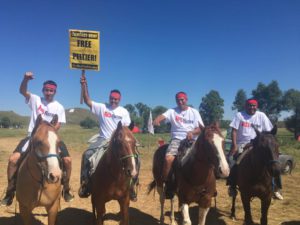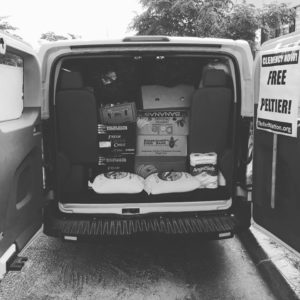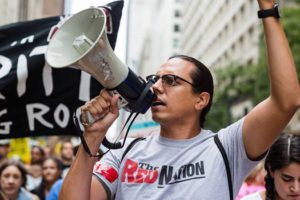
For the past few weeks, people across the continent have been watching what is happening in Standing Rock. Standing Rock is a reservation of the Standing Rock Sioux in North Dakota. The struggle there revolves around the building of the Dakota Access Pipeline across the reservation’s water. The Dakota Access Pipeline is an investment of Dallas Energy Transfer, a huge corporation. The $3.8 billion dollar project is to transport oil from Bakken oil field in North Dakota to Illinois, and possibly further. On Sept. 9, as a result of the struggle, the U.S. government stepped in over the head of a federal judge and requested that the company temporarily halt pipeline construction under the water source. The struggle continues to permanently stop the pipeline.
This pipeline is a response to the development of fracking technology in the past decade. This technology has led to oil exploration and extraction in places like North Dakota, making these places the scene of intense struggle over resource extraction, water rights and environmental destruction. Since much of North Dakota is Native land under U.S. federal control, these struggles boil down to environmental racism and the relationship of the U.S. government to Native tribes.

The Keystone Pipeline was based in this same fracking boom. The Northern section of the pipeline, the Keystone XL, which was planned to cross the Oglala Aquifer, was defeated last year. Pressure from Native activists, especially the Rosebud Sioux along with local white ranchers, made it a national political issue, resulting in it being halted by President Obama. The victory, thanks to the pressure of the activists, was inspiring. But capitalism still has oil to exploit.
The protest begins
The pipeline was originally supposed to go through Bismarck North Dakota, a 92 percent white community, so the Army Corps of Engineers rerouted the pipeline. Now the Standing Rock Sioux are planned to bear that contamination risk. In addition to the issue of water contamination, the corridor for building the pipe is cutting through areas with known burials, stone circles and other sacred sites. The environmental racism and class character of the entire project is obvious. Private companies use the most oppressed and under-resourced populations to take the brunt of their profiteering destruction. This story should ring true with people in Flint, Michigan, who have been fighting against water contaminated with lead; the Navajo Nation that was impacted by the Gold King Mine Spill; people in New Mexico who are suffering the country’s radioactive waste; and people in Nigeria, Ecuador, India and worldwide.

Protests began in the spring of 2016. On Aug. 4 the Standing Rock Sioux Tribal leadership requested an injunction on the building of the pipeline to Federal Courts.
On Aug. 11, as the protests started growing, tribal leader David Archambault II and over a dozen other protestors were arrested for refusing to leave the road accessing the construction site. A few days later when they were released, the company threatened to sue the protesters for the loss of money that day. This is what sparked the protest into a bigger incident. After the first arrests, twitter tweets from celebrities like Sherman Alexie and Leonardo DiCaprio, and a successful social media campaign around the hashtag #NoDAPL spread across the internet.
On August 15, David Archambault II, Chairman of the Tribe reached out to Indigenous people around the world:
“To all Native American Tribes in the U.S. and to all Indigenous Peoples of the world…Please stand with Standing Rock by issuing proclamations, resolutions, and/or letters of support.”
Around 100 Native nations from across the continent have passed resolutions or sent letters in support of the Standing Rock Sioux. The National Congress of American Indians has supported the cause. The United Nations Permanent Forum on Indigenous Issues sides with the Standing Rock Soiux. The letters the tribes send draw on spiritual significance, tribal sovereignty, and put this aggression against Native land into historical context. Urban working class Native people identify with this struggle. From reservations and off-reservation cities (where four out of five Native people live), they are sharing live stream stories across social media. They are organizing donation drives to get water and blankets to the protesters. They are traveling to the protest camp in the hundreds to join in the historic fight.
Protests are militant
Since the Aug. 11 stand-off and arrests, over a thousand people have made it to the site to refuse the pipeline.
On Aug. 31, Dale “Happi” American Horse climbed construction equipment and chained himself to the machine as others built a cast around his arms and chain. This was a heroic act in a planned effort by a militant grouping of protestors called the Red Warrior Camp. After 6 hours of halted construction, police and firefighters were able to remove him amidst a cheering and singing crowd of support.
Early on, kitchens were organized. Food, being donated from locals or brought in from hundreds of miles, is cooked and served.
On Sept. 4, videos started circulating on social media and mainstream media showing how the protesters have successfully delayed construction several times. Security forces were unable to keep the protesters back because protesters crossed fences in unison. The security forces used attack dogs and mace to try to deter the group of militant protestors. Several dog bites drew blood. Protestors who had dealt with mace in the past were able to use that experience to help first time protesters wash their eyes. Chants kept the group bonded together despite the intensity of the GS4 security. With rocks, sticks, and a deep refusal to leave, viewers witnessed a victory. The security forces, dumbfounded at the resilience of the protest, backed away, entered their trucks and left the area.
From Natanii Means:
“I watched DAPL private security bring HUGE VICIOUS badly trained attack dogs out on women and children!! They released the dogs as we were pushing them back and forcing them to leave. The dogs ran into the crowd and attacked a woman, bit her on the chest, and the leg, then one dog went after a horse and the horse kicked it. But he still made the horse bleed. More people were attacked and they pepper sprayed people in the front. One dog even turned on his owner and bit him three times, they were frightened animals. It’s hard to reframe my anger as I write this. And it’s hard for me not to cuss, but I will say today we forced them to stop AGAIN. And to those cowards working security, things come full circle, and I hope you get what’s coming to you by the great mystery. You released dogs into a crowd of unarmed peaceful protectors. Today was a win. But tomorrow is still a fight. Pray for the frontline.”
The security forces used by the construction company are contracted from the GS4 company. This company is the world’s biggest security company and is used as security for pipeline, mining, and fracking sites in the U.S. and Canada. This is also the infamous company that the Israeli government, with U.S. funding, uses to police Indigenous Palestinians with checkpoints and prisons. Palestinian organizers are following this event and sharing the story.
Protest bringing organizers together
The groups who are arriving include Idle No More (based in Canada), The Red Nation (based in the Southwest U.S.), Black Lives Matter, American Indian Movement, leaders from tribal governments, non-profits and NGOs, and hundreds of Native and non-Native people from as far as Alaska and Hawaii who are not currently in with organizations. A handful of celebrities have joined the protest, donating their fame to increase publicity.
The significance of the Black Lives Matter Movement identifying with the struggle is that revolutionary organizers understand the need for multinational unity against the racist capitalist system. The Red Nation has been instrumental in organizing solidarity actions with Black Lives Matter causes in other cities. Multinational unity is necessary to defeat the white-supremacist capitalist system. In the face of growing white-supremacist ideas and fascism, this is a very important development!
The significance of tribal governments supporting the Standing Rock Sioux is that tribal leadership is willing to stick their necks out despite possible criticism from the U.S. government. These tribal governments see their water protection fights as related. Tribal governments understand that their struggles for meeting the needs of their nations are not competitions for limited resources but one struggle of unity for tribal control of resources.
From Nick Estes, co-founder of The Red Nation:
“Narrow nationalism and hyper localism have been the status quo and the biggest barriers to native and non-native organizing. what is happening in standing rock is dismantling that backwards thinking — it is re-opening the crevasses of a broad native struggle that crosses, interrupts, and shuts down the divisions created by the reactionary elements of so-called progressive movements who have been attacking the tactics and unity of #nodapl. as those forces retreat into irrelevance, the sleeping giant is awakening and rediscovering its true power. that power does not lie in a community garden, a non-profit, or self-serving individualism. it is bigger. it is solidarity. it is love for the people, the land, and the water. those on the frontlines, at the construction site and in the cook shack, are the ones we should be supporting and spending our time and energy worrying about. the #allwatermatters reactionaries, law enforcement, and the state politicians are all working to undermine what they have always feared most, people taking power and destiny into their own hands. the call has been issued. we have responded with our hands, resources, love, and labor. let’s continue to build the movement and focus on the people that matter, our beautiful and brave relatives in standing rock, Tatanka Iyotake’s people, the people of Sitting Bull. hecetu welo!”
The media is not neutral. The state is not neutral
This is the largest Native protest since Wounded Knee in 1973. Social media is on fire. Hundreds are carpooling. State politics are in a state of emergency. For the level of importance this has, corporate news is not reflecting that. They are almost silent.
The state however is not silent.
On August 19 North Dakota Governor Dalrymple declared a “state of emergency,” claiming the need to “manage public safety risks associated with the protest.” Outside law enforcement and militarized equipment can now be brought in. Ironically, three days later, water supplies and medical trailers were removed from the area. The governor’s administration claims this was for the safety of medical and water resources. We really know that dehydration and lack of medical attention is being used by the state as punishment for speaking up.
Police have shut down the main highway in the area and set up checkpoints to deter supporters from bringing donations or themselves into the protest camp. Cars are stopped and eyed. If the officers suspect the carload is supporting the protest they are forced to turn around.
And the authorities push every possible way to stop or discredit resistance. State police and the FBI have announced an investigation into alleged use of laser pointers against surveillance aircraft.
Experienced organizers remember how biased the state is. COINTELPRO (the FBI’s counter intelligence program) was a systematic program to rig trials like that of Leonard Peltier, murder revolutionaries as in the case of Fred Hampton, and infiltrate organizations. It was used to destroy the movement for liberation. We are seeing the state’s true nature again. There is no real free speech or free assembly when it threatens the capitalist state.
Native people gathering to demand their rights are so threatening to the system that a state of emergency has been declared.
Nationally, these protests are happening in a time of renewed Native struggle. Native organizers are fighting racist mascots, replacing Columbus Day with Indigenous Peoples’ Day, rallying against racial profiling and police brutality, and demanding tribal sovereignty over water rights. Indigenous people are still here and are militantly coordinating a resistance.





